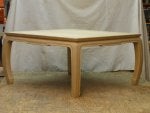I am ready to try scrapers, but would appreciate advice on which ones to start with. My initial use would be to clean up the fine lines caused by nicks in the thickness planer knives.
I have seen various card scrapers. Many come in a three scraper set like these:
https://www.amazon.com/DCT-Carbon-Steel-Scraper-3-Piece/dp/B076PPXKJ2
https://www.amazon.com/DFM-Blue-Curved-Cabinet-Scraper/dp/B07S2DT3K5
More expensive, with burnisher:
https://www.amazon.com/Crown-Tools-Scraper-Burnisher-Clifton/dp/B00EW6N9VA
Here are similar six-piece sets:
https://www.amazon.com/piece-Cabinet-Scraper-Set-Woodworking/dp/B074WG63NL
https://www.amazon.com/Shop-Fox-D3294-Scraper-6-Piece/dp/B000OS6124
I have also seen handles with replaceable blades and tips, like the Bahco 665:
https://www.amazon.com/Bahco-Premium-Ergonomic-Carbide-Scraper/dp/B000288LP6
There are other scrapers. Some use razor blades. Some look like they are more for painting.
-> Which scrapers do you use and recommend for general woodworking?
-> Does brand matter?
-> How do you prefer to sharpen them?
I have seen various card scrapers. Many come in a three scraper set like these:
https://www.amazon.com/DCT-Carbon-Steel-Scraper-3-Piece/dp/B076PPXKJ2
https://www.amazon.com/DFM-Blue-Curved-Cabinet-Scraper/dp/B07S2DT3K5
More expensive, with burnisher:
https://www.amazon.com/Crown-Tools-Scraper-Burnisher-Clifton/dp/B00EW6N9VA
Here are similar six-piece sets:
https://www.amazon.com/piece-Cabinet-Scraper-Set-Woodworking/dp/B074WG63NL
https://www.amazon.com/Shop-Fox-D3294-Scraper-6-Piece/dp/B000OS6124
I have also seen handles with replaceable blades and tips, like the Bahco 665:
https://www.amazon.com/Bahco-Premium-Ergonomic-Carbide-Scraper/dp/B000288LP6
There are other scrapers. Some use razor blades. Some look like they are more for painting.
-> Which scrapers do you use and recommend for general woodworking?
-> Does brand matter?
-> How do you prefer to sharpen them?





